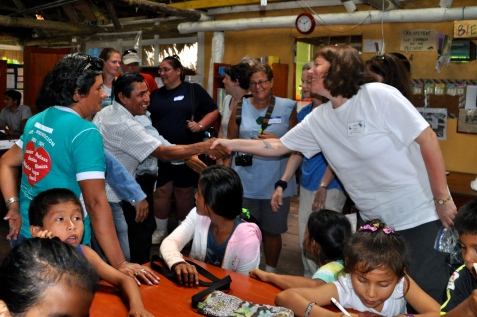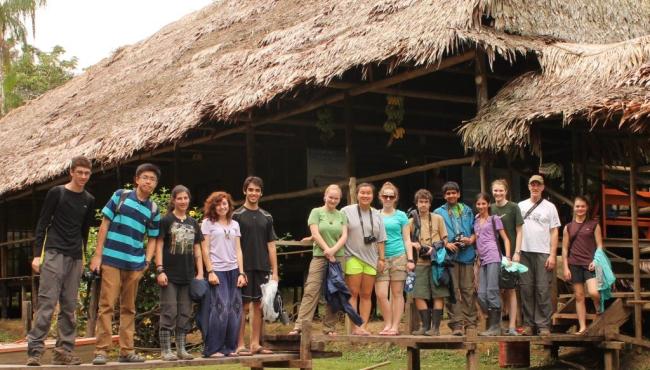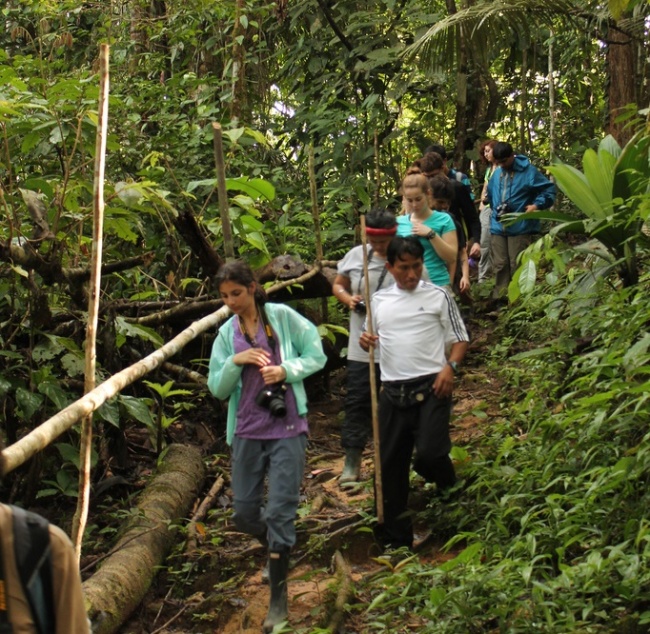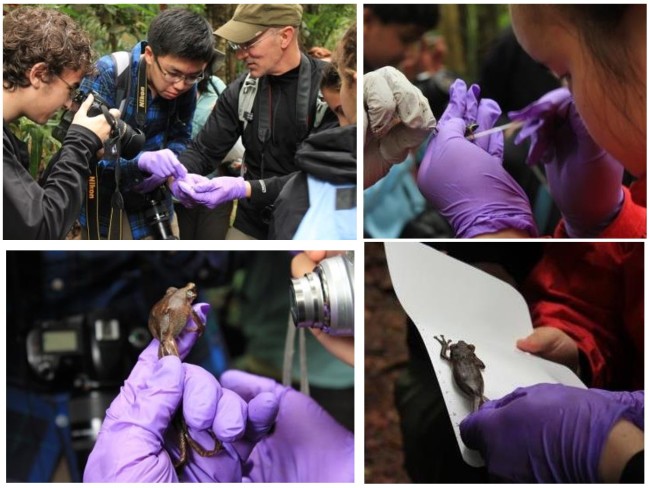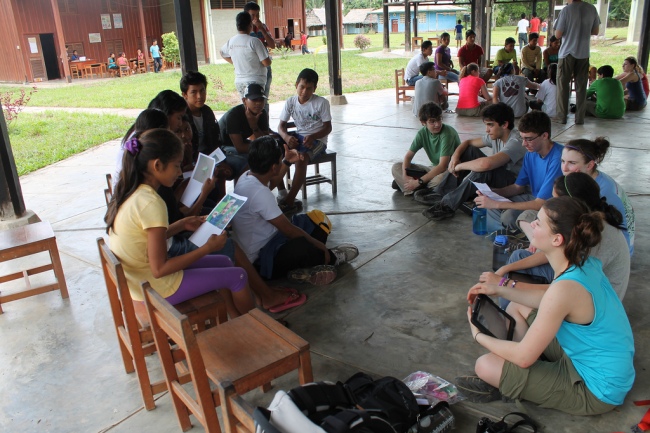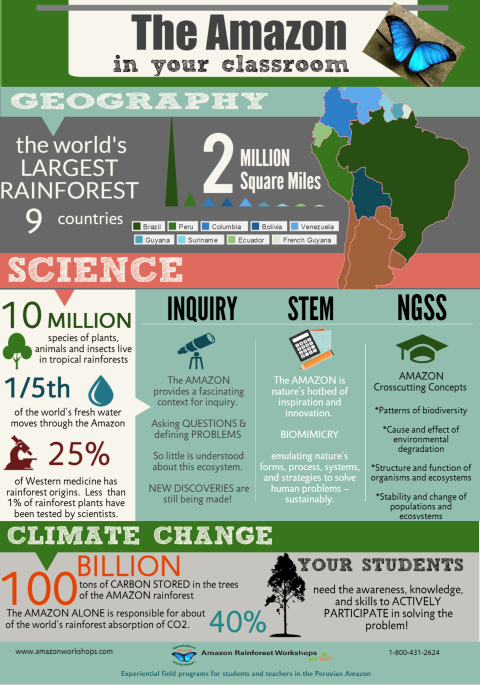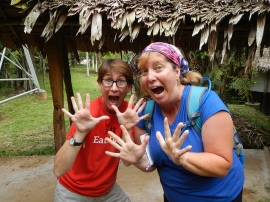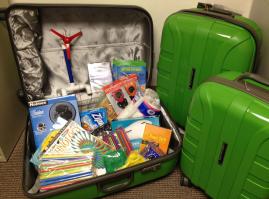Winging It: Birding as a Contact Sport?
December 4, 2014
It’s all fun and games until you get birds and the Cornell Lab of Ornithology involved…then mayhem, hilarity, and learning ensue!
Last summer, birding in the Amazon became a full contact sport as U.S. and Peruvian educators and students raced around the grounds outside the Amazon library – flapping their “wings” as they searched for resources needed to survive! Language barriers dissolved as hands were clasped and teams were formed. Laughter filled the air as educators learned to communicate with hand signals and pantomime.
How does magic like this happen? It takes partnerships and a lot of planning, but it is so worth it! During the annual Educator Academy in the Amazon for K-12 teachers, we partner with the Cornell Lab of Ornithology to bring their BirdSleuth programs to the Amazon.
While they are in the Amazon, U.S. educators work with Lilly Briggs, Cornell’s International BirdSleuth Coordinator, and are introduced to the new Habitat Connections curriculum. This great program uses inquiry, games, and citizen science to help students discover the diverse habitat need of birds and the challenges they face when migrating. We then partner with CONAPAC’s Amazon Library and host a similar teacher training for Peruvian educators – many of which have to travel for hours by boat to make the training.
The high point of all this in-depth exploration is an afternoon of fun and community building between U.S. and Peruvian teachers. Together we “field test” several Habitat Connections activities with the students who visit the Amazon library after school each day.
 It was an experience none of us will ever forget, but we left with way more than just happy memories. All of us have new tools and resources that will improve our teaching and engage our students – whether we teach in a one room school in the Amazon, a private school in NYC, or an elementary school in Tuscola, Illinois.
It was an experience none of us will ever forget, but we left with way more than just happy memories. All of us have new tools and resources that will improve our teaching and engage our students – whether we teach in a one room school in the Amazon, a private school in NYC, or an elementary school in Tuscola, Illinois.
So how does all this translate back to a US classroom? Here’s how one teacher took what she learned in the Amazon and integrated it into her classroom.
Connecting the Amazon to the Classroom via BirdSleuth 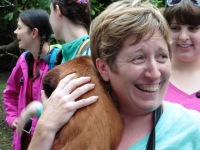
by Pam White-Evans, 6th grade teacher at Jefferson Elementary School in Tuscola, IL.
(Pam teaches math, science, and social studies but if she ever needs another career she has a real talent for talking to howler monkeys in rehab!)
“Our first science unit of the year this fall was Birdsleuth’s Habitat Connections. It was very interactive and the students really enjoyed this aspect of the curriculum.
The first lesson was “Habitat Investigation.” This lesson gave the students a chance to get outside and explore their schoolyard. We had one particular area in mind that we would like to improve, so we studied it extensively. This was the start of information gathering for a grant that we applied for. The students were introduced to the idea of citizen science. It was an idea they really liked. We got out our binoculars and took a bird walk and practiced taking data to input into eBird.
The second lesson (and their favorite!) was “Migration Obstacles.” It was a beautiful, slightly windy, rather warm day when we did this activity. This activity is so much fun because everyone is involved in some way during the exercise. Improvising “hazards” makes it interesting. Our hazards ranged from a “ghost” building to wetlands to glass buildings and an airstrip, cars to cats. The children enjoyed being the hazard as well as trying to dodge the hazards. It wasn’t as easy as they thought it would be. We talked about ways to improve the migration route and make it more bird friendly. Then they tried again and were much more successful.
There are some very good slides to go along with each lesson. We looked at the migration routes that certain birds followed. They were interested to see the birds that were in South America near the area where we visited the Amazon.
The third lesson “Bird Survivor” teaches about the life cycle of birds in an interactive game. The “Fact or Fiction” is a good way to get them thinking about some common misconceptions they may have about birds. For example, do all birds build nests? The survivor games goes through the life cycle of birds by having some students be the bird and the rest of the class telling them their fate. In the end, not all are successful. It is sometimes hard being a bird!
The fourth lesson “To Migrate or Not” looks at tropical and temperate residents and migrants. Talking about tropical migrants was the perfect time to talk about the birds in the Amazon! Through my eBird account we looked at many of the birds I had seen while visiting. We could then see if they were migratory birds or if they lived in the area year round. The students were able to see additional hazards of migration. This tied in with the sixth lesson “Modeling Migration” that takes a close look at eBird. Students were able to look closely at data and learn to decipher what the graphs were trying to tell them.
The fifth lesson is “Scientist in Action.” I don’t believe that too many of the students had thought that scientists actually study birds and what they do. Nate Senner’s activities intrigues the students. They found his study interesting, but many thought it would be really hard to do that.
The seventh and final lesson is “Improve Your Bird Habitat.” After going through all the lessons, we took another look at the area that we would like to improve in our school yard. We decided to make the area an outdoor classroom where we can observe birds and other wildlife, as well as attract Monarch butterflies. We went through the grant application, so the students could see what needed to be done. They drew sketches and helped write the answers to the questions. We look forward to finding out whether or not we will be funded for our project!
I ended the unit with a slideshow of pictures from my trip to the Amazon. The students were intrigued by the pictures and the information that I shared with them.”
So what’s next?
We have another Educator Academy in the Amazon scheduled for July 1-11, 2015. This year, as part of the program, we will conduct two BirdSleuth training for U.S. and Peruvian teachers and expand our reach deeper into the Amazon so we can share this wonderful resource with even more Amazon teachers and students. This is our way of giving back and thanking the Amazon and its people for allowing us to use their backyard as our classroom!
We’d love to have you join us! More info on the 2015 Educator Academy can be found here: http://www.amazonworkshops.com/educator-academy.html
Blind Dates in the Amazon
November 6, 2014
Standing on the banks of the Sucasari River as dusk began to settle around me, I strained to hear the sound of approaching boats over the cacophony of rainforest insects and frogs. 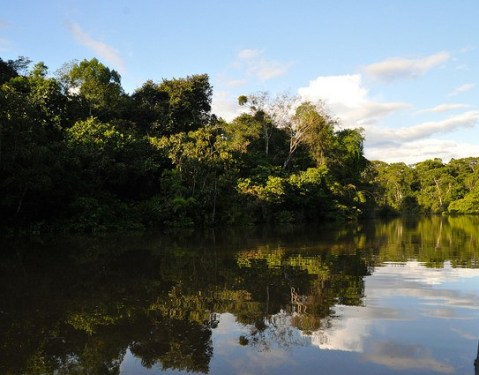
I had only emerged from the jungle two hours earlier after spending over a week with high school students exploring the rainforest from top to bottom – my personal version of heaven. With just enough time for quick shower and a clean set of clothes, I needed to regroup – and quickly. I had to be ready to greet a boat of weary educators who had just spent the better part of two days traveling to this remote corner of the Amazon rainforest in Northeastern Peru. I knew their names and some of their faces, but we had never met in person.
Feeling like I was about to go on a blind date with 28 people all at once, I could feel the butterflies of nervous anticipation taking wing in my stomach. Who were these people that I would spend the week with? (I’ve been at this long enough to know educators can be WAY harder than students!) Was I ready for them? Were they ready for me?
Could they handle the ambitious agenda I had planned in order to cram as many learning, exploring, and discovery opportunities as possible into our short time together? In the end, would they be able to justify the fees they had paid to attend this K-12 science professional development experiment that I (along with my amazing Amazon faculty) had dreamed up? Would they embrace the adventure with gusto and not balk at the rustic conditions, the heat, the humidity, the mud, and the biodiversity in the latrines?
Would they find their inner explorer and ring every last drop of wonder out of each experience we threw at them?  Could they get up before dawn, bird before breakfast, dig up leaf cutter ant nests till noon, climb through the rainforest canopy after lunch, and keep going long after dark in search of nocturnal wildlife along rainforest trails? Would we, together, be able to successfully build curriculum connections between these amazing Amazon experiences and the classroom?
Could they get up before dawn, bird before breakfast, dig up leaf cutter ant nests till noon, climb through the rainforest canopy after lunch, and keep going long after dark in search of nocturnal wildlife along rainforest trails? Would we, together, be able to successfully build curriculum connections between these amazing Amazon experiences and the classroom?
Or, would they revolt and retreat to the hammocks, exhausted, nursing their frustrations with pisco sours and cervezas, while plotting a mutiny?
Finally, the sound of outboard engines parted the curtain of rainforest noise and two boats full of the 2014 Educator Academy participants rounded the bend in the river.
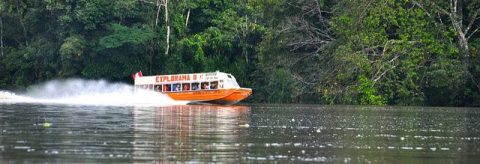
In short order, 28 disheveled, but smiling bodies emerged from the covered boats. As the educators clambered up the steps to the lodge, I could see a wonderful mix of anticipation, curiosity, excitement, and awe wash over their faces as they took in the Amazon rainforest for the very first time – mirroring the euphoria and relief felt when you realize your blind date is going to be way better than expected! It was immediately evident that my 28 “blind dates” were more than up for the adventure we had planned.
Little did any of us know just how life changing the next 8 days would be, how close we would all become, and how the Amazon would transform the ways we think and teach. No one could have anticipated how the Amazon would refuse to let us go once we returned home.
“This program immersed me into life on the Amazon River. I am forever changed by the knowledge, stories, challenges and life-long friendships developed during this experience!” ~Melissa Jordan, 2014

Are you ready for the blind date of a lifetime? Registration is open and scholarships are available for the 2015 Educator Academy in the Amazon. Learn more and download the syllabus here.
Submitted by Christa Dillabaugh, Director, Educator Academy in the Amazon
Spring Break 2014: Wet and Wild in the Amazon!
April 3, 2014
As students return to their classrooms following spring break, many will share their stories of beaches with friends and family. But for thirteen students from the Derryfield School in New Hampshire, the conversation will be very different:
“So what did you do on spring break?”
“Not much…just traveled to the Amazon, slept under mosquito netting, checked for bats in the toilets, braved torrential downpours in the rainforest canopy, and did research on tiny poison dart frogs. How ‘bout you?”
That is exactly what this band of intrepid explorers did – and then some!
Jack Sanford, a teacher at The Derryfield School in New Hampshire, led this group of amazing young explorers into the heart of the Peruvian Amazon. Their mission was to search for amphibians and monitor them for the chytrid fungus that is causing mass extinctions of amphibians around the world.
With the guidance of Marcy Sieggreen, amphibian expert from the Detroit Zoo, the Derryfield students hiked along rainforest trails day and night in search of frogs. Using international monitoring protocols, the students swabbed frogs of all sizes and colors to determine if chytrid is a growing threat in the Amazon.
Their samples will be analyzed by Sieggreen and contribute to the Detroit Zoo’s ongoing research in the area. Additional data collected by Sanford and his students will be analyzed by Sanford’s advanced biology students as part of a year-end project.
Talk about applying biology to real world problems! These young explorers had a first-hand taste of what it means to be a field biologist in a very magical and yet challenging environment. The weather is unpredictable, the frogs do not always cooperative, and the variables of a research question are not easily controlled. This, my friends and fellow educators, is what real science and science teaching is all about!
You may ask, “Why travel to the Amazon to do a project like this, when we can monitor frogs in our own community?” A good question!
Sanford and his students have the answer. They monitor frogs in New Hampshire as well, but wanted to make a personal connection and contribution to this global crisis. During their visit to the Amazon, they met with students from the “Amazon Amphibians Protector Club.” This small band of students from the village of Llachapa and their committed teacher, Carmen Shuta, regularly work with Marcy Sieggreen and submit their amphibian observations to her via field journals and digital cameras. Sanford and his students organized an exchange with Shuta’s students and shared information about the frogs of North America – including photos, fast facts, and even frog calls.
As a result, plans are being made to continue this type of exchange using skype and email. The hope is that the Derryfield/Llachapa exchange will serve as a model for student to student international collaboration and will build awareness and appreciation not only for environmental issues like amphibian decline, but also deepen cultural awareness and appreciation between US and Amazon students.
So what’s next? Sanford and his students are in the process of adopting an Amazon school and through their efforts they will provide school supplies and fresh drinking water to their peers in Peru. They are working on an amphibian photo book to share with their new friends in Llachapa and will continue to work with Sieggreen to identify the frogs they monitored in Peru and analyze the data they collected. Someday soon, we hope another group of Derryfield students will be back in Peru to continue what this wonderful group of intrepid field biologists began.
Many, many thanks to Jack Sanford, Marcy Sieggreen, guides Willy Flores Lanza and Luis Mayanchi Del Aguila, the administration from the Derryfield School and our partners at Explorama and CONAPAC. Without your incredible leadership, none of this would be possible!
Would you like to give your students an alternative spring break in the Amazon? You can! Click here for more info on Amazon Rainforest Workshops for Students
Just when you thought you knew everything about sloths…
February 5, 2014
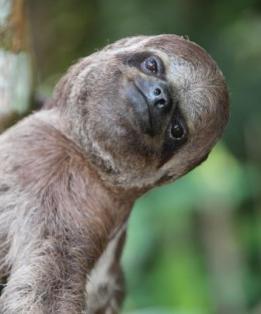
Sloths have been making headlines this week – They even got a feature in the New York Times!
Maybe you thought all you really needed to know about sloths is that they are sloowwww, like to hang out in trees, are kind of a greenish brown, and are just about the cutest things that live in a rainforest. Or maybe you are a sloth aficionado and you regularly amaze your friends with your humorous stories about sloth defecation and the moths that love it. Oh wait? You haven’t heard that one?
Ok, before I reveal the newest, MIND BENDING, HEADLINE MAKING DISCOVERY about sloths, let’s go over the basics.
1. Two of the most common sloths in Neotropical rainforests are the 2-toed sloth and the 3-toed sloth.
2. Both types of sloths like to hang out in trees.
3. Three-toed sloths tend to have a lot of “things” that live in their hair. Things like cockroaches, round worms, and moths, to name a few. (It’s ok to be thinking EEWWWW right now!)
4. The 3-toed sloth also has an, umm, well, “unusual” bathroom habit. (Probably not a shocker based on what you just learned). In order to “take care of business,” 3-toed sloths actually climb down from the top of the tree to the forest floor to defecate. As you can image, that is a really long and slow trip back and forth to the bathroom. Plus this can be risky if there happens to be a jaguar down there waiting for you!
5. While the sloth is down on the ground, the pregnant moths that live in its hair scurry out and lay their eggs in the feces – a fancy term for poop – because apparently sloth moth larva do best on a strict diet of sloth dung. (Yes, another EEEWWW is a perfectly normal response)
6. The sloth moth larva munch happily away in their sloth dung play pen until they transform into adult moths. Now that they are all grown up, the dung pile just doesn’t cut it anymore. The adult moths fly up into the canopy in search of a new home on the back of a sloth. If they are lucky a mate awaits, cozily protected by the sloth’s course hair – and the cycle starts all over again.
If you are happily humming the Circle of Life song, wait just one minute! We are NOT done yet!
7. Turns out that as the moths go about their daily lives in the hair of a sloth, they leave behind a lot of nitrogen. Guess what likes nitrogen? Come on …guess! Yes, algae likes nitrogen, especially green algae.
8. Ah ha! The algae gives the sloth its green color and this helps the sloth blend into its environment – kind of a grow your own camouflage with moths providing the fertilizer deal.
Up until now this is where the story ended. BUT WAIT…There is more!
9. New research has revealed evidence that sloths might actually eat the algae that grows in their hair. Algae is actually quite nutritious and would help to supplement the sloth’s less than stellar diet of leaves. Researchers have found that the more moths a sloth has, the more nitrogen is held in its coat. More nitrogen = more algae to eat! (Preliminary research found algae in sloth stomachs, so the researchers are definitely on to something!) Hmmmm, maybe running the risk of being eaten by a jaguar is worth guaranteeing a steady supply algae in your hair?
AND NOW for the really MIND BLOWING PART. Are you ready?
10. You will never guess what else is growing alongside the algae. Really, you never will, but go ahead and try if you want. Can’t guess? Ok – are you ready…FUNGI, freakin’ fungi. But not your average, run of the mill fungi – fungi with super powers. Researchers have discovered that the fungi that live on sloth hair have potent ANTI-CANCER, ANTI-BACTERIAL, and ANTI-PARASITIC properties! Is it possible that the sloth is cultivating its very own pharmacy??
I don’t know about you, but that just leaves me flabbergasted and awestruck. Some curious person made observations, asked WHY, and opened their mind to possibilities! They not only uncovered another piece of an already crazy natural history story….they might possibly have discovered a new source of medicines that have the potential to treat nasty things like malaria, Chagas disease, and even certain forms of breast cancer.
This is why cultivating a curious mind matters – it is the foundation of scientific thinking. This is why rainforests and the creatures that live there matter. This is why science in the rainforest matters! Discoveries like this put rainforests back in the spotlight as an untapped resource for inspiration, knowledge, medicines, and more – a natural resource far more valuable as an intact and healthy ecosystem.
One final note: Researchers don’t know yet if there is a relationship between the algae and the fungi, but I for one wouldn’t be at all surprised if there was!
For more detail on these latest discoveries go to:
http://www.nytimes.com/2014/01/28/science/the-sloths-busy-inner-life.html?_r=1
http://blogs.plos.org/everyone/2014/01/18/rainforest-fungi-find-home-sloth-hair/
For you uber science heads, here’s the journal article about the fungi discovery:
http://www.plosone.org/article/info%3Adoi%2F10.1371%2Fjournal.pone.0084549
Amazon Super Heroes Caught Moonlighting as K-12 Educators!
October 3, 2013
If we’ve heard it once, we’ve heard it a thousand times…the future of the planet depends on the students sitting in our classrooms. As educators, the task of nurturing this next generation to appreciate the role of science in addressing local as well as global problems often falls to us. At times this may seem like a super human task that requires a spandex suit and a cape.
Happily, our 2013 Educator Academy in the Amazon participants are redefining what it means to be a super hero. They have traded in their capes for rain ponchos, field notebooks and i-buttons.
They are becoming role models for their students because they understand that as teachers they need to participate in science themselves in order to incorporate science methods in their classrooms. They need to use inquiry-based techniques in order to guide their students in the tools and skills of research. They need to experience critical ecosystems, such as the Amazon in order to teach about their importance to global health.
Here are a few examples of what our Amazon Super Heroes are up to!
Science Explorers, EcoFest, and the Wooster Elementary Environmental Science Club
Jennifer R. and Jolene W., Arkansas, Elementary Educators. This dynamic duo from Arkansas truly don’t need capes to rank as Amazon super heroes.

They epitomize what it means to be “facilitators of wonder” as they lead their students on explorations of their school yard nature trail, engage them as citizens during a community wide EcoFest, and integrate an appreciation for the wonders of nature into every lesson they teach.
“Our 4th and 5th grade Environmental Science Club set up a Rainforest Awareness informational board at EcoFest in Conway. They displayed an experiment that showed the importance of keeping trees in the Rainforest because of the effects on the water. It also communicated the need for clean drinking water and school supplies for the people of Peru. We have shared our personal encounters and pictures with our students so that they are able to empathize with those people. We want our students not to take things for granted and appreciate their education.”
You can read more about the Wooster Elementary Science explorers on their blog: http://richardsonscienceexplorers.blogspot.com/
Biodiversity and Butterflies
Kathryn E., Oklahoma Middle School Educator and Fund For Teachers Fellow. With all the new standards coming out, it can take super human efforts to re-imagine classroom instruction. But great educators like Kathryn take it all in stride. Kathryn is turning her classroom into a rainforest as a way to energize science content and engage her students – while still meeting the standards and finding time to be a Fund For Teachers Fellow and Fulbright Distinguished Educator too!
“How can an educator not bring amazing information from the Amazon back to the classroom? With lessons and activities ranging from fishing for piranhas to teaching S.T.E.M in the classroom, I gained valuable experiences and content knowledge to enhance my ecology unit. I am much more confident in my teaching about the attributes of the rainforest, symbiotic relationships, and natural resources. For example, when discussing symbiotic relationships with my students, I was able to use examples I observed first-hand in the Amazon rainforest. Little by little the Amazon rainforest is coming alive in my classroom. For the first time, I have a large butterfly habit to observe and record the life cycle and then students will be researching tropical butterflies compared to the butterflies found in North America. Next, there will be fish in the classroom and learning about the pink river dolphin and piranhas. Then, I will bring in orchids, bromeliads, and ferns to teach about the trees and epiphytes of the rainforest. By the end of the semester, my classroom will be quite the example of a rainforest.”
Connecting the Desert to the Rainforest
Amanda R., Nevada, US Park Service. One can only imagine what Amanda could do if she actually had a super hero costume! This desert dynamo is on a non-stop mission to share the wonders of the world with all the visitors she works with as part of her job with the National Park Service. She somehow still finds time to do things on the side – like creating rainforest “GreenBoxes” for the GreenPower program at the Desert Research Institute which will provide educators with hands-on teaching activities and materials that show just how much the desert and the rainforest have in common!
“The goal of these green boxes will be to provide a diversity of hands-on investigations by using such resources as GLOBE, STEM, Project Noah, and the 5 E inquiry model. With this goal in mind, this will be one of the many bridges that teacher can use to educate youth in Clark County and throughout the state of Nevada and the country of Peru.”
Urban Science Superstars
Holly M., Massachusetts, Middle School Educator. After returning from the Amazon, Holly launched the school year with a “DonorsChoose” project request to raise money to purchase the equipment her students will need to become citizen scientists and collect environmental data for the GLOBE program. Holly’s students come from an urban school surrounded by buildings and cement. It is a diverse, inner city school with 91% of students designated as High Needs due to low income status, English Language Learner status or Special Education status. Nearly 66% of the children come from families where English is not their primary language.
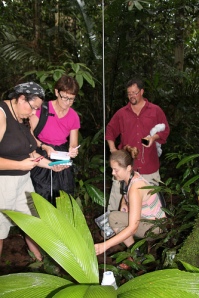
“My goal, as their middle school science teacher, is to expose them to technology, make science authentic and investigative and show them what real scientists do, while bringing as much of the natural world into my classroom as possible. I was inspired by the data collection I did as a participant in the 2013 Educator Academy and I want to share this excitement with my students. By collecting data, using an exact protocol, and contributing to a scientific community, it is my hope that they will feel empowered and energized, just as I did in the Amazon”
Read all about Holly’s DonorsChoose proposal and then start your own!
More Amazon Super Hero Profiles Coming soon! Rainforest Alliance Schools in Jacksonville, FL, Biomimicry Science Fair Projects in Colorado, Watershed Collaborations in the Mid Atlantic, and More!
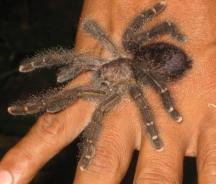 Let’s be honest…looking for tarantulas on the ceiling before sitting down to dinner is not considered normal. Nor is checking for frogs in the shower before you shampoo. But as many of our Amazon travelers will attest, there is an undeniable sense of pride and accomplishment when you can actually say you’ve done this! There are definite benefits to traveling to places in the world that take you to the edge of your comfort zone.
Let’s be honest…looking for tarantulas on the ceiling before sitting down to dinner is not considered normal. Nor is checking for frogs in the shower before you shampoo. But as many of our Amazon travelers will attest, there is an undeniable sense of pride and accomplishment when you can actually say you’ve done this! There are definite benefits to traveling to places in the world that take you to the edge of your comfort zone.
It is on this un-comfortable edge where:
1. perspectives are changed
2. passions are discovered
3. adventurous souls are awakened
4. routines are broken
5. true callings are revealed
6. futures are redefined
7. independence takes root
8. the most surprising people become friends
9. life altering experiences occur
10. real growth and learning happen!
Take for example, the tarantula on the ceiling. When it fell from the rafters onto the dinner table, naturally a collective gasp (and a few shrieks) erupted around the room. But after the initial shock, these were replaced with awe and wonder. The student closest to the airborne arachnid overcame her phobia and calmly held her ground, much to the awe of her peers! This in turn inspired others to take a closer look as researcher, Steve Madigosky, gently collected it and explained it was a pink-toed tarantula (Avicularia sp.).
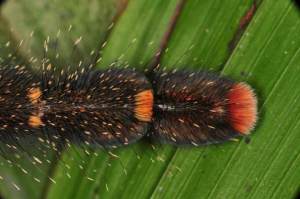
Sure enough it looked as if each of the eight toes had been dipped in pink nail polish, prompting oohs and ahhs instead of squeals and shrieks from the audience. Someone then asked the obvious question, “What was it doing on the ceiling?” Much to everyone’s surprise, Steve explained that there are arboreal (tree dwelling) tarantulas in the Amazon, uniquely adapted to life in the treetops. The beauty that landed on the dinner table had simply lost her footing but because she was built for tree top living, she survived the fall just fine.
When Steve asked if anyone would like to hold it, the response was overwhelmingly positive and students patiently waited for their turn to feel the delicate touch of 8 pink toes on their skin. In this unscripted travel experience, perspectives were changed, fears were overcome, routines were broken, and new passions discovered…
When was the last time you checked for tarantulas on the ceiling? If you haven’t, maybe it’s about time!
Amazon Rainforest Floods U.S. Classrooms!
September 12, 2013
We’ve said it before, and we can’t help but say it again…” What happens in the Amazon should never stay in the Amazon!”
Each and every year the educators and students we have the privilege to share the Amazon with give life to these words. Each and every year the wonders of the Amazon are carried back to friends, families, classrooms, communities, as students and teachers share what they have learned and experienced. Each and every year we do our best to build Amazon Awareness through education!
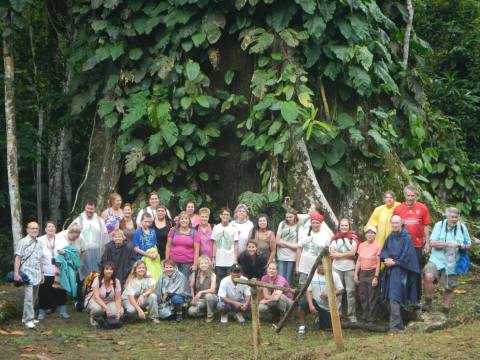 In July of 2013, we broke recent records and hosted 30 intrepid educators on our first annual Educator Academy in the Amazon. Students from Sidwell Friends School and Shady Side Academy (to name a few) explored the rainforest on reconnaissance for their schools in order to build long term relationships with the Amazon. For adults and students alike, this immersion into tropical ecology, research, and culture gave all of us the chance to challenge ourselves, our assumptions, and our responsibilities.
In July of 2013, we broke recent records and hosted 30 intrepid educators on our first annual Educator Academy in the Amazon. Students from Sidwell Friends School and Shady Side Academy (to name a few) explored the rainforest on reconnaissance for their schools in order to build long term relationships with the Amazon. For adults and students alike, this immersion into tropical ecology, research, and culture gave all of us the chance to challenge ourselves, our assumptions, and our responsibilities.
As educators we sought new knowledge and insights to inspire our teaching and motivate our students. As individuals, many of us wanted an adventure in a remote and wild part of the planet. For some it was an opportunity to rekindle a long lost passion. For others it was an opportunity to push beyond established comfort zones. Many found it a means to look at the world with a new set of eyes.
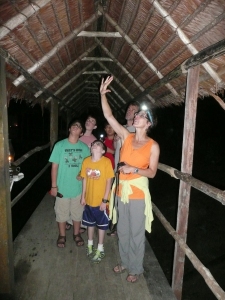 In addition to total immersion (tarantulas falling from the ceiling and bats flying out of latrines) into Amazon biodiversity, we engaged in hands-on investigations, citizen science research projects, and inquiry-based learning activities designed to deepen our understanding of the rainforest ecosystem and its global importance. We even explored how rainforest concepts relate to 21st century instructional models such as 5E lesson design, inquiry-based exploration, STEM education. Innovative instructional tools such as Project Learning Tree, GLOBE, and Project Noah gave us practical tools to take back to our classrooms. Cross curricular learning experiences focused on cultural exchange, service learning, and sustainability and provided us with even more inspiration for how to deepen our student’s understanding of the complexities global environmental issues.
In addition to total immersion (tarantulas falling from the ceiling and bats flying out of latrines) into Amazon biodiversity, we engaged in hands-on investigations, citizen science research projects, and inquiry-based learning activities designed to deepen our understanding of the rainforest ecosystem and its global importance. We even explored how rainforest concepts relate to 21st century instructional models such as 5E lesson design, inquiry-based exploration, STEM education. Innovative instructional tools such as Project Learning Tree, GLOBE, and Project Noah gave us practical tools to take back to our classrooms. Cross curricular learning experiences focused on cultural exchange, service learning, and sustainability and provided us with even more inspiration for how to deepen our student’s understanding of the complexities global environmental issues.
In this age of high stakes testing, Next Generation Science Standards, and the Common Core, we pondered how to take what we experienced in the Amazon and make it relevant to our curricula, our classrooms, and our students. What bound us all together was the idea that rainforests are magical, wonderful, inspiring places and they deserve a place in our curriculum. Not because monkeys are fun and frogs are fabulous (they are!) but rather because rainforests hold the key to many of our most pressing environmental issues – including global climate change.
The future of our planet depends on our students becoming concerned scientists, responsible environmental policy makers and informed global citizens. Knowledge and skills in science are paramount. How do we nurture this next generation to appreciate the role of science in addressing local as well as global problems related to climate change, sustainable development, and resource conservation? As teachers and teacher educators, we need to participate in science ourselves in order to incorporate science methods into our classrooms. We need to use inquiry-based techniques in order to guide our students in the tools and skills of research. We need to experience critical ecosystems, such as the rainforest, in order to teach about their importance to global health.
In June 2014, another cohort of educators from across the united states will have the unique opportunity to explore these issues through our second annual Educator Academy in the Amazon.
In addition, educators from Arizona and Nevada and other desert states can enroll in a spin off program, the Desert to Rainforest Academy, coordinated by Arizona State University faculty. The Desert to Rainforest Academy participants will engage in hands-on investigations, citizen science research projects, and inquiry based learning activities in both desert and rainforest ecosystems. During the Desert to the Rainforest Educator Academy, participants will get a close-up view of both the desert and the rainforest as complex systems with narrow niches and the interconnected relationships between soil, water, plants, wildlife, climate and people.
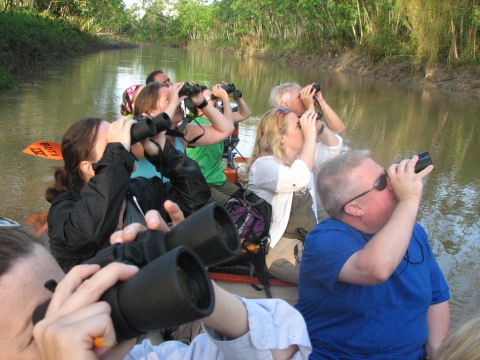 Both of these programs encourage the development of a “new set of glasses” for one’s local environment and provide a wider context for exploring significant questions such as – What is biodiversity and why does it matter to me? What factors determine the biodiversity of the desert, the Amazon, my backyard, and the planet? How will climate change affect the many dimensions of the Amazon ecosystem? How will it affect us locally in Arizona? Why is access to water a global concern? As a global citizen, what is my responsibility?
Both of these programs encourage the development of a “new set of glasses” for one’s local environment and provide a wider context for exploring significant questions such as – What is biodiversity and why does it matter to me? What factors determine the biodiversity of the desert, the Amazon, my backyard, and the planet? How will climate change affect the many dimensions of the Amazon ecosystem? How will it affect us locally in Arizona? Why is access to water a global concern? As a global citizen, what is my responsibility?
Participants in next summer’s Academy programs will be charged with sharing and applying what they learn with their students, districts, and communities. And once again…the Amazon will flood U.S. Classrooms!
For more information on Rainforest Educator Academy Programs and how you can participate, please visit http://www.amazonworkshops.com/educators–naturalists.html or contact Christa Dillabaugh, christa@amazonworkshops.com / 1-800-431-2624.
Amazon here we come!
June 26, 2013
Wow! This year we are celebrating 22 years of building Amazon awareness through our summer workshop programs and we are pulling out all the stops! This year we will host:
30 Adventurous Educators
26 Student Explorers
7 Teacher Leaders
6 Awesome Faculty Members
5 Student Amazon Rainforest Workshops
and
1 Stupendous Educator Academy in the Amazon!
Our student participants will experience an adventure like no other as they explore rainforest ecology, community, and culture. They will push past comfort levels, expand their worlds, experience the joy of unplugging from technology and make new friends!
Their dedicated teacher leaders – amazing men and women – will serve as role models, guides, and co-learners as they lead their students on an unforgettable, life-changing learning experience. 
The educators participating in our Educator Academy spent 6 weeks preparing for their Amazon experience and are already laying plans for bringing the Amazon back to their classrooms and communities. If the energy they put into their pre-departure preparations is any indication, the Amazon will be rocking when they hit the ground!
There is no doubt that the Amazon will change each and every one of us…but our task is to decide what WE are going to do in return. How will we change the Amazon? What is our responsibility in ensuring its sustainable future?
As Margaret Meade once said, “Never doubt that a small group of thoughtful, committed citizens can change the world. Indeed, it is the only thing that ever has.”
We have no doubt that our small group of 2013 Amazon explorers fit her description and they will have plenty of ideas for making a difference! Stay tuned for future blog posts with details!
Have you ever been awe-struck by nature’s engineering prowess and thought to yourself, “how in the world is that possible?” or “wouldn’t it be great if humans could do that?” Did it ever occur to you to think of nature as a big research and development firm with over 3 million consultants and over 3.8 billion years of experience? Welcome to the world of biomimicry – a world where creative and thoughtful people are looking to nature for inspiration.
bi-o-mim-ic-ry:
Learning from and then emulating natural forms, processes, and ecosystems to create more sustainable designs.
According to Janine Benyus, of the Biomimicry Institute, “…nature has already solved many of the problems we are grappling with; energy, food production, climate control, benign chemistry, transportation, and more.” Designers, engineers, architects and other innovators are asking the question “What would nature do here?” and are finding not just one new idea but myriad time tested, environmentally appropriate, solutions.
What better place to explore the idea of biomimicry than the Amazon – nature’s hotbed of innovation and inspiration?
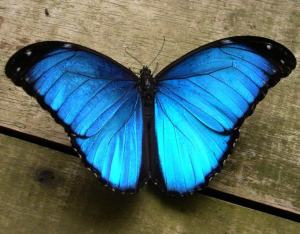 Take for example this lovely blue morpho butterfly. The new “glare-free” e-reader screens were inspired by blue morphos and “mimic” how the wings absorb and reflect different wavelengths of light!
Take for example this lovely blue morpho butterfly. The new “glare-free” e-reader screens were inspired by blue morphos and “mimic” how the wings absorb and reflect different wavelengths of light!
Taking a walk down a rainforest trail takes on a whole new meaning if you thinking like a biomimic. Each plant and animal you encounter is uniquely adapted to survive and thrive using a minimal amount of resources, creating a minimal amount of waste, and leaving behind a minimal impact on the environment. Every organism a source of inspiration, a blueprint of design, a model of sustainability.
Now imagine using biomimicry as a focus for STEM education – asking your students to study a leaf to learn how to make solar cells or a spider to make resilient fibers. Imagine them learning how to adhere like a gecko, create color like a butterfly, sequester carbon like a mollusk, and air condition like a leaf cutter ant.
This summer students and teachers will put on their biomimicry hats and prowl the Amazon rainforest in search of inspiration – learning from nature, not just about nature.
If you’d like to learn more about biomimicry and find K-12 teaching resources visit Biomimicry 3.8



